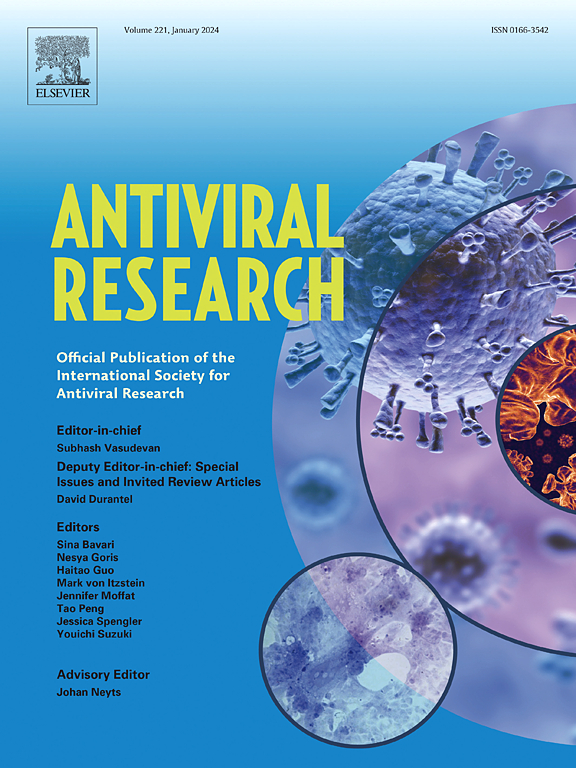CVA16 infection causes neurological injury by engaging TLR2/MYD88/TNF-α/CXCL1 signalling pathway in hSCARB2 knock-in mice
IF 4.5
2区 医学
Q1 PHARMACOLOGY & PHARMACY
引用次数: 0
Abstract
Coxsackievirus A16 (CVA16), a major pathogen responsible for hand-foot-and-mouth disease (HFMD) in children, has frequently replaced Enterovirus A71 as the predominant causative agent in China and other Asia-Pacific regions. The lack effective drugs and vaccines against this virus exacerbates the concerns on its outbreaks. Clinical reports and laboratory studies indicate that CVA16 infection may lead to neurological injury, but the precise mechanisms remain elusive. In this study, we meticulously established a CVA16 murine disease model using 3-week-old hSCARB2 knock-in mice through intracranial inoculation. Within 4–7 days post-infection, the infected mice exhibited severe neurological symptoms featured as limb paralysis, hind limb weakness and ataxia. Furthermore, high viral loads were detected in the brain, spleen, skeletal muscle tissues, indicating a systemic infection. A robust cytokine response was observed, characterized with the elevation of TNF-α, IL-12 (p40), IL-10 and MIP-1β. Histological and immunofluorescence staining revealed extensive inflammation, marked by the concentrated infiltration of astrocytes cells, as well as severe neurological injury, which included hypertrophic and extended pseudopodia microglia, increased astrocytes with long and stretched protuberances, markedly decreased neuronal cell bodies and nerve fibers in brain. No visible pathological changes were observed in spinal cord tissues. RNA sequencing and immunofluorescence staining of brain tissue verification assays indicated that the neurological injury may engage in TLR2/MYD88/TNF-α/CXCL1 signal pathway. Over all, this work addressed the gap in the availability of CVA16 disease rodent model for vaccine development and provided novel insights into the mechanisms underlying neurological injury caused by enteroviruses and other neurotropic viruses.
hSCARB2敲入小鼠CVA16感染通过参与TLR2/MYD88/TNF-α/CXCL1信号通路导致神经损伤
柯萨奇病毒A16 (CVA16)是导致儿童手足口病(手足口病)的主要病原体,在中国和其他亚太地区经常取代肠病毒A71成为主要病原体。缺乏针对这种病毒的有效药物和疫苗加剧了人们对其爆发的担忧。临床报告和实验室研究表明,CVA16感染可能导致神经损伤,但其确切机制尚不清楚。在本研究中,我们利用3周龄hSCARB2敲入小鼠,通过颅内接种,精心建立了CVA16小鼠疾病模型。感染后4-7天内,感染小鼠出现肢体瘫痪、后肢无力和共济失调等严重神经系统症状。此外,在脑、脾、骨骼肌组织中检测到高病毒载量,表明全身感染。观察到强烈的细胞因子反应,其特征是TNF-α, IL-12 (p40), IL-10和MIP-1β升高。组织学和免疫荧光染色显示广泛的炎症,星形胶质细胞集中浸润,严重的神经损伤,包括伪足小胶质细胞肥大和延伸,长而拉伸的星形胶质细胞增加,脑内神经元细胞体和神经纤维明显减少。脊髓组织未见明显病理改变。RNA测序和脑组织免疫荧光染色证实,神经损伤可能参与TLR2/MYD88/TNF-α/CXCL1信号通路。总的来说,这项工作解决了CVA16疾病啮齿动物模型用于疫苗开发的可用性的空白,并为肠病毒和其他嗜神经病毒引起的神经损伤机制提供了新的见解。
本文章由计算机程序翻译,如有差异,请以英文原文为准。
求助全文
约1分钟内获得全文
求助全文
来源期刊

Antiviral research
医学-病毒学
CiteScore
17.10
自引率
3.90%
发文量
157
审稿时长
34 days
期刊介绍:
Antiviral Research is a journal that focuses on various aspects of controlling viral infections in both humans and animals. It is a platform for publishing research reports, short communications, review articles, and commentaries. The journal covers a wide range of topics including antiviral drugs, antibodies, and host-response modifiers. These topics encompass their synthesis, in vitro and in vivo testing, as well as mechanisms of action. Additionally, the journal also publishes studies on the development of new or improved vaccines against viral infections in humans. It delves into assessing the safety of drugs and vaccines, tracking the evolution of drug or vaccine-resistant viruses, and developing effective countermeasures. Another area of interest includes the identification and validation of new drug targets. The journal further explores laboratory animal models of viral diseases, investigates the pathogenesis of viral diseases, and examines the mechanisms by which viruses avoid host immune responses.
 求助内容:
求助内容: 应助结果提醒方式:
应助结果提醒方式:


